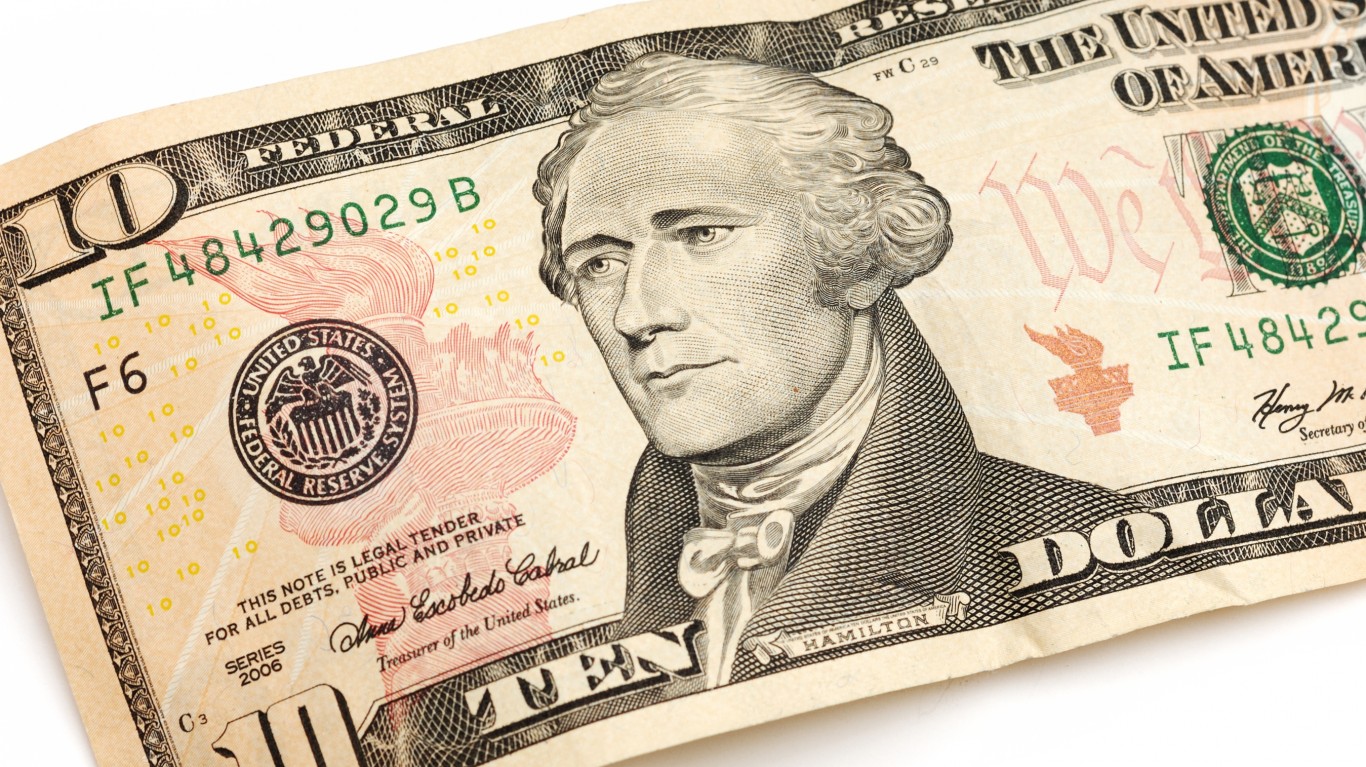Median household income in the United States declined for the second straight year, according to data released from the U.S. Census Bureau today. Income was $50,502 in 2011, more than 8% below the 2007 pre-recession peak. Source: Wikimedia Commons/creative commons
Source: Wikimedia Commons/creative commons
Read: America’s Richest States
Read: America’s Poorest States
While the trend is generally down, some states fared far better than others. Median income ranged from $36,919 in Mississippi to $70,004 in Maryland, positions both states have held since before the recession. Based on the 2011 Census Bureau American Community Survey, 24/7 Wall St. identified the states with the highest and lowest median household income.
Between 2010 and 2011, Vermont was the only state where median income increased. Income fell in 18 states and remained statistically unchanged in 31. In Hawaii, which remained one of the wealthiest states in the country, median income decreased by more than $3,000 between 2010 and 2011 alone.
Not surprisingly, poverty rates continued to be high. The percentage of Americans living below the poverty line increased in 17 states between 2010 and 2011, the third consecutive increase for ten of these states. Of the states with the lowest income, eight had among the 10 highest poverty rates. Mississippi had the highest poverty rate in the country, at 22.6% of residents, compared to the national rate of 15.9%.
The poorest states in the country are almost entirely found in the South, with the exception of New Mexico. The wealthiest states can be found all across the country, including three in New England, four in the Mid-Atlantic, and two outside the contiguous 48 states.
Of course, not all residents of the wealthiest states earn as much as the median. According to the Census Bureau’s Gini Coefficient, which measures income inequality, there was a significant increase in the divide between the rich and poor in 20 states. The measure remained unchanged in the rest.
Though income inequality affects rich and poor states alike, the poorest states struggle with it most. Inequality was high in only three rich states: California, Massachusetts and Connecticut. Meanwhile, with the exception of West Virginia, all of the poorest states had among the highest income inequality scores, with six in the top 15.
In an interview with 24/7 Wall St., Brookings Institution fellow Elizabeth Kneebone explained that income inequality at a state level is often influenced by differences between the state’s high- and low-income cities and between urban and rural areas. “These are metropolitan economies that drive a lot of these [state] trends.” This was especially the case in California, where the Bay Area’s wealthy suburbs have incomes fueled by the tech industry and the low-income areas in other parts of the states are agricultural-based economies.
At least one positive development involves health insurance coverage, which increased in 37 states. While the poorest states improved, coverage remained relatively low. Three of the poorest states were among the 10 with the lowest coverage. In New Mexico, nearly 20% were not insured in 2011, much higher than the 15.1% national average. In the wealthiest states, coverage was among the highest, with four states having greater than 90% insured.
While most of the states with the lowest incomes suffer from weak economies, unemployment was not a significant problem. Only two states were among the worst 10 for unemployment in 2011. In fact, five of the worst-off states had unemployment rates lower than the national rate of 8.9% last year. In Oklahoma, one of the poorest states, unemployment was 6.2%. In the states with the highest median incomes, the results were similarly varied.
According to Kneebone, it is not a surprise that unemployment and income appear unrelated. “Earnings for middle and lower-wage workers have fallen or stagnated over time,” Kneebone explained. “So you can have a situation where jobs are being created … but the types of jobs matter. If those are jobs that pay low wages, even if you’re working full time, that might not be enough to lift you above the poverty line.”
To identify the states with the highest and lowest median household income, 24/7 Wall St. reviewed state data on income, poverty, and health insurance from the U.S. Census Bureau’s 2011 American Community Survey (ACS). Based on Census treatment, median household income for all years is adjusted for inflation. We also reviewed unemployment data provided by the Bureau of Labor Statistics and additional 2011 ACS data on individual cities. Because the cost of living has a direct bearing income, 24/7 Wall St. considered cost of living data for Q4 2011 from the Council for Community and Economic Research.
These are America’s richest states.
America’s Richest States
10. California
> Median household income: $57,287
> Population: 37,691,912 (the highest)
> Unemployment rate: 11.7% (2nd highest)
> Pct. below poverty line: 16.6% (18th highest)
California’s economy was hit especially hard by the housing downturn. Between the end of 2006 and the end of 2011, housing prices fell 46.7%, the fourth-largest decline in the country. Median income in the state has dropped steadily since a 2007 high of $65,005, while the poverty rate has climbed from 12.4% in 2007. Unemployment, meanwhile, has increased to 11.7% by 2011, second only to Nevada and well below the national rate of 8.9% that year. California’s cities are found at both ends of the income spectrum. Four of the 10 wealthiest cities in the country with populations of more than 100,000 are affluent suburbs of either San Francisco or Los Angeles. Meanwhile, California towns like Stockton, Victorville and Fresno, located inland, have among the highest poverty rates in the country.
9. Delaware
> Median household income: $58,814
> Population: 907,135 (6th lowest)
> Unemployment rate: 7.3% (16th lowest)
> Pct. below poverty line: 11.9% (11th lowest)
Delaware — the second smallest state by area and sixth least populous in the country — also happens to be one of the richest. Favorable corporate tax laws have led more than 60% of America’s Fortune 500 companies to incorporate in the state, increasing its tax revenue substantially. Almost 6% of the families in the state earned more than $200,000 last year, one of the highest proportions among all states. Meanwhile, fewer than 10% of the state’s residents were without health insurance in 2011, the eighth-lowest across the nation.
Also Read: The World’s Best (and Worst) Economies
8. Hawaii
> Median household income: $61,821
> Population: 1,374,810 (11th lowest)
> Unemployment rate: 6.7% (11th lowest)
> Pct. below poverty line: 12% (12th lowest)
Since reaching $70,401 in 2008, when it ranked fifth nationally, median income in Hawaii has declined every year, while the poverty and unemployment rates have gone up. From 2007 to 2011, the percentage of families living below the poverty line increased from 8% to 12%, while the unemployment rate rose from 2.7% to 6.7%. Despite all this, Hawaii remained relatively wealthy. The state’s poverty and unemployment rates for 2011 were well below the national benchmarks.
7. Virginia
> Median household income: $61,882
> Population: 8,096,604 (12th highest)
> Unemployment rate: 6.2% (8th lowest)
> Pct. below poverty line: 11.5% (8th lowest)
Virginia’s unemployment rate in 2011 was much better than the national rate of 8.9%. Overall, the state’s economy is quite healthy, an issue that will no doubt be in focus in the upcoming election. As a key swing state, the question is whether voters give credit for this to President Obama or Republican Gov. Bob McDonnell. The northern region of the state, outside the Washington D.C. area, included the three wealthiest counties in the U.S. In the city of Arlington, located in the capital region, nearly 20% of families earned more than $200,000 annually, almost four times the national rate. However, the wealth does not spread out to the rural regions of the state where 3.7% of families earned less than $10,000 a year, a large percentage for a state that is considered wealthy.
6. New Hampshire
> Median household income: $62,647
> Population: 1,318,194 (9th lowest)
> Unemployment rate: 5.4% (4th lowest)
> Pct. below poverty line: 8.8% (the lowest)
New Hampshire is the first of three New England states among the nation’s 10 wealthiest. It is just one of eight states where median income exceeded $60,000 in 2011. In addition to a high median income, the state has proportionally few poor residents. The state’s poverty rate was just 8.8% last year, the lowest in the nation. Also,only 2.7% of families earned less than $10,000, which, along with Vermont, was the lower than any other state in the country. With only 5.4% of the New Hampshire’s workforce unemployed in 2011, most residents were able to earn enough to avoid poverty.
5. Massachusetts
> Median household income: $62,859
> Population: 6,587,536 (14th highest)
> Unemployment rate: 7.4% (18th lowest)
> Pct. below poverty line: 11.6% (9th lowest)
Massachusetts’s median income is well off its 2008 high of $68,055. Just under 10% of families in the state made more than $200,000 in 2011, the fourth-highest rate in the country. Massachusetts also had the lowest percentage of the population without health insurance in 2011, at a mere 4.3% — a whopping 10.8 percentage points below the national rate. The high rate of insured residents has much to do with a 2006 law signed by then-Gov. Mitt Romney. The law provided near universal health care coverage to all Massachusetts citizens. Among cities with populations of 100,000 or more, three Massachusetts cities — Boston, Worcester and Cambridge — had the lowest proportion of residents without health insurance at 5.5% or less compared to a national rate of more than 15%.
4. Connecticut
> Median household income: $65,753
> Population: 3,580,709 (22nd lowest)
> Unemployment rate: 8.8% (19th highest)
> Pct. below poverty line: 10.9% (5th lowest)
Connecticut is one of only three states, along with Maryland and New Jersey, to have had a higher percentage of families earning more than $200,000 a year than families living below the poverty line. The western region of the state is home to a sizable population of hedge funds, and their employees, along with residents who work in New York’s financial district, helping drive up the state’s median income. Second only to New York, Connecticut had one of the largest gaps between the rich and the poor. At nearly 11%, the proportion of families living below the poverty line in Connecticut is the fifth lowest in the country. Meanwhile, 11.2% of families earned more than $200,000 in 2011, the highest proportion of all states.
Click here to see how all fifty states do with 24/7 Wall St.’s new interactive state tool.
3. New Jersey
> Median household income: $67,458
> Population: 8,821,155 (11th highest)
> Unemployment rate: 9.3% (14th highest)
> Pct. below poverty line: 10.4% (3rd lowest)
In New Jersey, 10.9% of families earned more than $200,000 last year and just 10.4% of residents lived below the poverty line, fewer than all states except for New Hampshire. Still, there were areas in the state where poverty was more widespread. In Newark, 31.6% of residents lived below the poverty line, while Paterson’s poverty rate was 28.9%. In contrast to the state as a whole, families in Newark were more than 16 times more likely to earn less than $10,000 than over $200,000 a year. Similarly, in Paterson, 16.2% of families earned under $10,000 per year, while just 1.4% earned more than $200,000 annually.
2. Alaska
> Median household income: $67,825
> Population: 722,718 (4th lowest)
> Unemployment rate: 7.6% (22nd lowest)
> Pct. below poverty line: 10.5% (4th lowest)
In 2011, Alaska moved ahead of New Jersey to take the spot of the state with the second-highest median household income in the country. The state benefits from its vast natural resources, particularly oil, natural gas, and timber. Since 1957, the state has collected nearly $100 billion in taxes from oil and gas companies, and Alaska oil production has accounted for more than 13% of total U.S. production. Most residents reap the benefits from these payments. Income inequality in the state is the second-lowest in the country. Just 3% of Alaskan families earned less than $10,000 per year compared to the 5.1% nationwide. Meanwhile, despite the state’s high median income, just 5% of families earned more than $200,000 per year.
1. Maryland
> Median household income: $70,004
> Population: 5,828,289 (19th highest)
> Unemployment rate: 7% (15th lowest)
> Pct. below poverty line: 10.1% (2nd lowest)
Maryland, which has had the highest median income of all states since 2006, was the only state in the country to have a median income above $70,000 in 2011. The state’s 10.1% was well below the national rate of 15.9%. Furthermore, a sizable portion of the population is earning well above the median income. Maryland is one of three states, along with New Jersey and Connecticut, where more than 10% of families earned more than $200,000 in 2011. Across the U.S., only 5.6% of families made more than $200,000 in 2011.
Michael B. Sauter, Samuel Weigley, Brian Zajac and Alexander E. M. Hess
Also Read: America’s Poorest States
Sponsored: Attention Savvy Investors: Speak to 3 Financial Experts – FREE
Ever wanted an extra set of eyes on an investment you’re considering? Now you can speak with up to 3 financial experts in your area for FREE. By simply
clicking here you can begin to match with financial professionals who can help guide you through the financial decisions you’re making. And the best part? The first conversation with them is free.
Click here to match with up to 3 financial pros who would be excited to help you make financial decisions.
Thank you for reading! Have some feedback for us?
Contact the 24/7 Wall St. editorial team.




